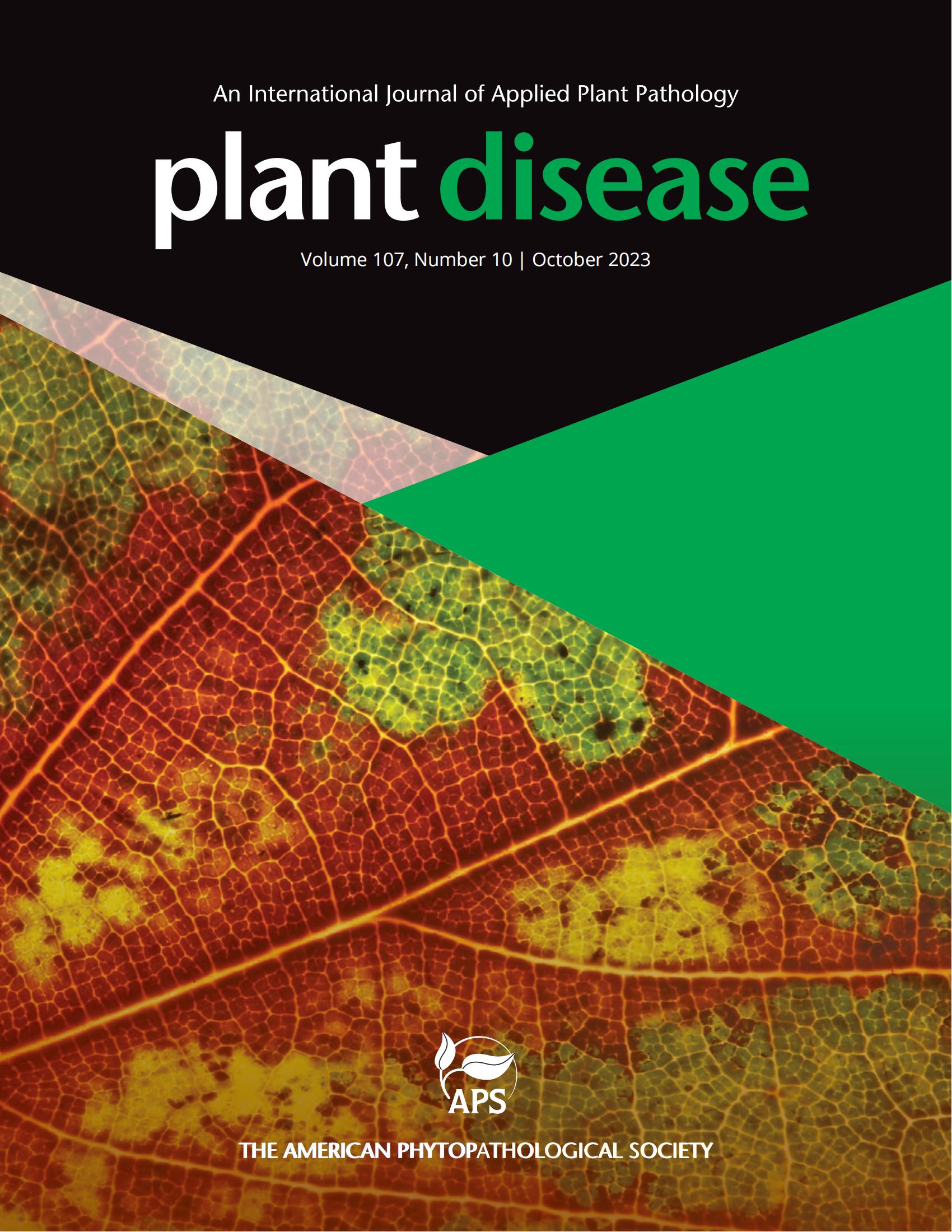中国由炭疽菌引起的油桐叶炭疽病报告初报。
摘要
孔雀花(Calathea orbifolia [Linden] H. a . Kenn.)在中国是一种有价值的室内植物。2024年9月,在中国广东省深圳(北纬22°35′55”,东经113°59′21”)的田间发现该植物叶片炭疽病。调查面积约900 m2,包括约300株植物。100株发病率约为70%。单株发病严重程度为叶片坏死20% ~ 60%。最初的症状是带黄晕的棕色斑点。斑点增大,伸长,不规则,0.5 ~ 9cm × 0.2 ~ 4cm,叶片枯萎死亡。收集10片有症状的叶片进行病原菌分离。病灶边缘小块(5×5 mm2)表面用1% NaClO消毒1分钟,70%乙醇消毒30秒,用无菌蒸馏水冲洗,置于PDA上,25℃孵育。3天后,用单菌丝尖端法在PDA上纯化真菌菌落。从不同植物样品中分离得到3株形态相似的真菌菌株(MBSZU 24-004 ~ MBSZU 24-006),分离频率为75%。在25℃下培养3天后,PDA上菌落呈白色,直径30 ~ 35mm,菌落呈灰白色,菌丝呈棉质,1周后菌落呈淡黄色。所有菌株都产生无性结构。刚毛深褐色,43.2 ~ 169.4 × 2.1 ~ 4.3µm,基部圆柱形,尖端渐尖。分生孢子隔生,透明到浅棕色,分枝。分生细胞透明,圆柱形至壶形,10.3 ~ 32.3 × 2.2 ~ 4.4µm。附着胞卵圆形到不规则,深褐色到黑色,6.2 ~ 18.9 × 5.7 ~ 10.1µm。分生孢子为单细胞,透明,壁光滑,圆柱形,端部圆形,有凹槽,9.5 ~ 20.6 × 3.6 ~ 6.2µm (n = 100)。在形态上,所有菌株都与C. gloeosporioides种复合体相似(Weir et al. 2012)。ITS、ACT、CAL、CHS-1、TUB2、GAPDH和ApMat基因使用引物对ITS5/ITS4、ACT- 512f /ACT- 783r、CL1C/CL2C、CHS-79F/CHS-345R、T1/T22、GDF1/GDR1和AMF1/AMR1进行扩增(Silva et al. 2012;Weir et al. 2012)。序列存入GenBank (ITS: PQ550808 ~ PQ550810;ACT: PQ558623至PQ558625;CAL: PQ558629至PQ558631;CHS-1: PQ558632至PQ558634;TUB2: PQ558626至PQ558628;GAPDH: PQ558635 ~ PQ558637;ApMat: PQ777471至PQ777473)。7个基因的最大似然系统发育分析表明,所有菌株均为暹罗菌。为检测致病性,本试验采用伤叶和未伤叶两种健康叶片。所有叶片用0.1% NaClO擦拭,然后用无菌水冲洗。将3株菌株的分生孢子悬浮液(15µl, 1 × 106个/ml)置于PDA上,25℃培养2周,采用附叶法。对照叶片用无菌蒸馏水模拟接种。每个处理10个重复,重复2次。将植株置于25°C,相对湿度80 - 85%的环境中。10 d后,接种伤叶和未接种伤叶均出现带黄晕的褐色病变,而对照叶则无症状。伤叶比未伤叶表现出更多的症状。菌株MBSZU 24-005毒力最强。从病变中重新分离出C. siamense,并通过形态学和DNA测序证实,符合Koch的假设。据我们所知,这是在中国和世界范围内第一次报道在圆叶菊上发现暹罗梭菌引起炭疽病。这种疾病可能对商业种植者造成经济影响,有必要监测其对中国孔雀植物生产的影响。Peacock plant (Calathea orbifolia [Linden] H. A. Kenn.) is grown in China as a valuable houseplant. In September 2024, leaf anthracnose was found on this plant in a field in Shenzhen (22°35'55"N, 113°59'21"E), Guangdong Province, China. The area investigated was ~900 m2 and included ~300 plants. Disease incidence was ~70% of 100 plants. Disease severity per plant was 20 to 60% necrotic lesions on the leaf. The initial symptoms were brown spots with a yellow halo. The spots enlarged, elongated, irregular, 0.5 to 9 × 0.2 to 4 cm, and leaves withered and died. Ten symptomatic leaves were collected for pathogen isolation. Small pieces (5×5 mm2) of lesion margins were surface sterilized in 1% NaClO for 1 min, 70% ethanol for 30 s, rinsed in sterile distilled water, placed on PDA, and incubated at 25°C. After 3 days, fungal colonies were purified on PDA using the single hyphal tip method. Three fungal strains (MBSZU 24-004 to MBSZU 24-006) with similar morphology were obtained from different plant samples with an isolation frequency of 75%. Colonies on PDA were white, 30 to 35 mm in diameter after 3 days at 25°C, then grayish white with cottony mycelia, the reverse pale yellow after 1 week. All strains produced asexual structures. Setae were dark brown, 43.2 to 169.4 × 2.1 to 4.3 µm, a cylindrical base, and an acuminate tip. Conidiophores were septate, hyaline to pale brown, and branched. Conidiogenous cells were hyaline, cylindrical to ampulliform, 10.3 to 32.3 × 2.2 to 4.4 µm. Appressoria were oval to irregular, dark brown to black, 6.2 to 18.9 × 5.7 to 10.1 µm. Conidia were one-celled, hyaline, smooth-walled, cylindrical, ends rounded, guttulate, 9.5 to 20.6 × 3.6 to 6.2 µm (n = 100). Morphologically, all strains resembled the C. gloeosporioides species complex (Weir et al. 2012). The ITS, ACT, CAL, CHS-1, TUB2, GAPDH, and ApMat genes were amplified using primer pairs ITS5/ITS4, ACT-512F/ACT-783R, CL1C/CL2C, CHS-79F/CHS-345R, T1/T22, GDF1/GDR1, and AMF1/AMR1 (Silva et al. 2012; Weir et al. 2012), respectively. Sequences were deposited in GenBank (ITS: PQ550808 to PQ550810; ACT: PQ558623 to PQ558625; CAL: PQ558629 to PQ558631; CHS-1: PQ558632 to PQ558634; TUB2: PQ558626 to PQ558628; GAPDH: PQ558635 to PQ558637; ApMat: PQ777471 to PQ777473). Maximum likelihood phylogenetic analyses of the combined seven genes identified all strains as C. siamense. To test pathogenicity, both wounded and unwounded healthy leaves were used in this experiment. All leaves were wiped with 0.1% NaClO and then rinsed with sterile water. Conidia suspensions (15 µl of 1 × 106 conidia/ml) of all three strains grown on PDA at 25°C for 2 weeks were placed on all samples using the attached leaf assay. Control leaves were mock-inoculated with sterile distilled water. Each treatment had 10 replicates and was repeated twice. Plants were placed at 25°C and 80 to 85% relative humidity. After 10 days, both wounded and unwounded inoculated leaves exhibited brown lesions with yellow halos, while the control leaves remained asymptomatic. Wounded leaves showed more symptoms than unwounded leaves. Strain MBSZU 24-005 was more virulent than the others. C. siamense was reisolated from the lesions and confirmed by morphology and DNA sequencing, fulfilling Koch's postulates. To our knowledge, this is the first report of C. siamense causing anthracnose on C. orbifolia in China and worldwide. The disease could economically impact commercial growers, necessitating monitoring of its effects on China's peacock plant production.

 求助内容:
求助内容: 应助结果提醒方式:
应助结果提醒方式:


